lesson3
- 格式:ppt
- 大小:1021.00 KB
- 文档页数:30
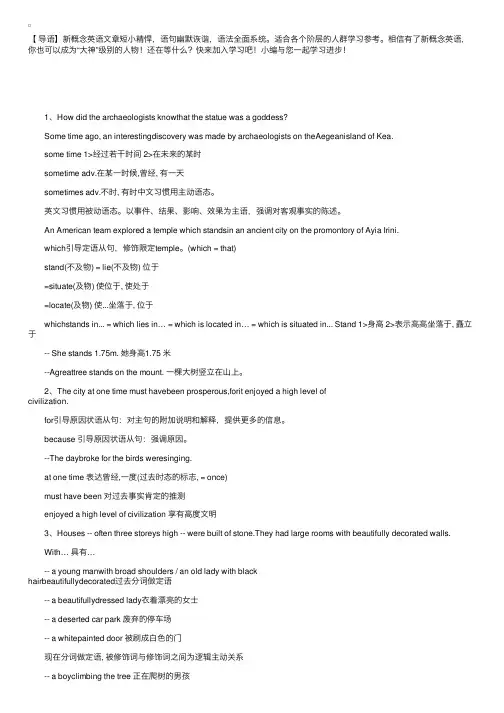
【导语】新概念英语⽂章短⼩精悍,语句幽默诙谐,语法全⾯系统。
适合各个阶层的⼈群学习参考。
相信有了新概念英语,你也可以成为“⼤神”级别的⼈物!还在等什么?快来加⼊学习吧!⼩编与您⼀起学习进步! 1、How did the archaeologists knowthat the statue was a goddess? Some time ago, an interestingdiscovery was made by archaeologists on theAegeanisland of Kea. some time 1>经过若⼲时间 2>在未来的某时 sometime adv.在某⼀时候,曾经, 有⼀天 sometimes adv.不时, 有时中⽂习惯⽤主动语态。
英⽂习惯⽤被动语态。
以事件、结果、影响、效果为主语,强调对客观事实的陈述。
An American team explored a temple which standsin an ancient city on the promontory of Ayia Irini. which引导定语从句,修饰限定temple。
(which = that) stand(不及物) = lie(不及物) 位于 =situate(及物) 使位于, 使处于 =locate(及物) 使...坐落于, 位于 whichstands in... = which lies in… = which is located in… = which is situated in... Stand 1>⾝⾼ 2>表⽰⾼⾼坐落于, 矗⽴于 -- She stands 1.75m. 她⾝⾼1.75 ⽶ --Agreattree stands on the mount. ⼀棵⼤树竖⽴在⼭上。
2、The city at one time must havebeen prosperous,forit enjoyed a high level ofcivilization. for引导原因状语从句:对主句的附加说明和解释,提供更多的信息。
![[全]新概念英语第一册 Lesson 3详解](https://uimg.taocdn.com/33d7b661b0717fd5360cdcef.webp)
新概念英语第一册Lesson 3详解1. umbrella [ʌm'brelə] n.伞umbrella 伞;雨伞;阳伞I felt a few spots of rain so I put my umbrella up. 我感到有几滴雨点,于是便撑起了雨伞。
I left another umbrella on the bus yesterday. 我昨天又把一把伞落在公交车上了。
2. please [pli:z] int.请♥A. please/pli:z/感叹词;感叹语;感叹句exclamation1. used to make a request more polite 好吗,请(用于客气地请求)Could I have two cups of coffee and a tea, please? 给我来两杯咖啡、一杯茶好吗?Please remember to close the windows before you leave.您离开前请记住关上窗户。
2. used to add force to a request or demand 请,求求你(用于加强请求或要求的语气)Please, David, put the knife down. 求求你,戴维,把刀放下。
Oh, please. Do shut up! 好了,别说了!3. UK used especially by children to a teacher or other adult in order to get their attention 让我说(尤指儿童为引起老师或其他成年人的注意时的用语)Please, Miss, I know the answer! 我来说,老师,我知道答案!4. used when accepting something politely or enthusiastically 行,谢谢用于礼貌或热情地接受某物时"More beer?" "Please."“再来点啤酒?”“好的。
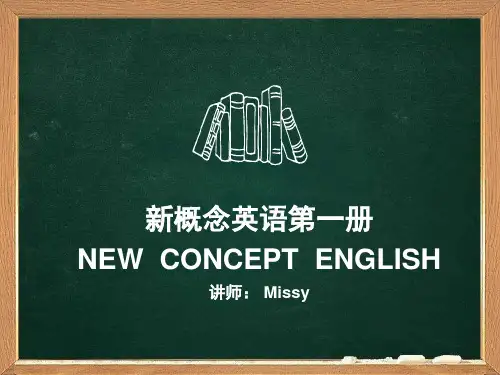

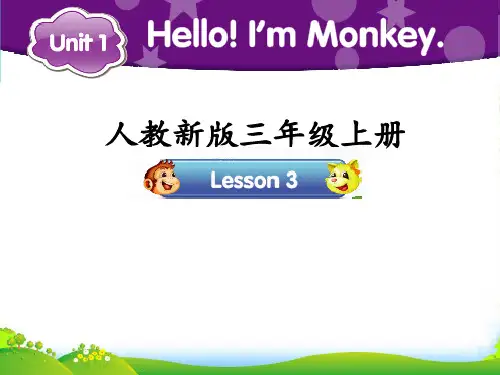
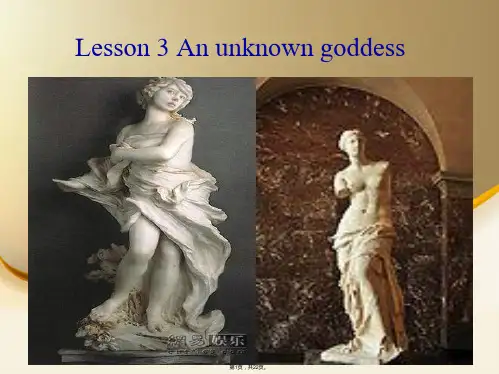


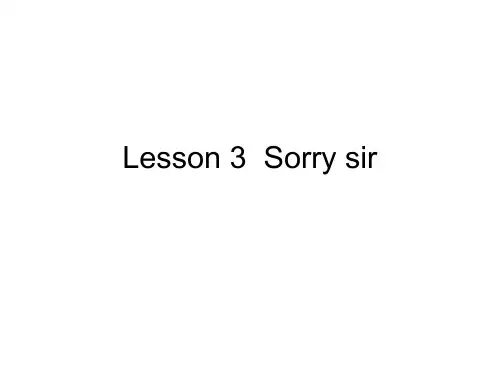

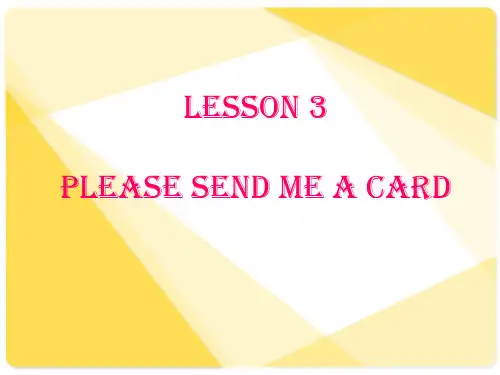
★⽆忧考新概念英语频道为⼤家整理的新概念英语第⼆册课⽂Lesson3,供⼤家参考。
更多阅读请查看本站频道。
Lesson 3 Please send me a card请给我寄⼀张明信⽚Postcards always spoil my holidays. Last summer, I went to Italy. I visited museums and sat in public gardens. A friendly waiter taught me a few words of Italian. Then he lent me a book. I read a few lines, but I did not understand a word. Every day I thought about postcards. My holidays passed quickly, but I did not send cards to my friends. On the last day I made a big decision. I got up early and bought thirty-seven cards. I spent the whole day in my room, but I did not write a single card!参考译⽂:明信⽚总搅得我假⽇不得安宁。
去年夏天,我去了意⼤利。
我参观了博物馆,还去了公园。
⼀位好客的服务员教了我⼏句意⼤利语,之后还借给我⼀本书。
我读了⼏⾏,但⼀个字也不懂。
我每天都想着明信⽚的事。
假期过得真快,可我还没有给我的朋友们寄过⼀张明信⽚。
到了最后⼀天,我作出了⼀项重⼤决定。
我早早起了床,买来了37张明信⽚。
我在房间⾥关了整整⼀天。
然⽽竟连⼀张明信⽚也没写成!Notes on the text 课⽂注释1. a few words,⼏句话。
•archaeology n. 考古学••词根部分archae-:源⾃自古希腊语,指ancient legends or history, 古代传说或者历史;••后缀-ology: the study of sth. 学科•●∙∙∙Some time 一段时间补充:形近表达sometime adv.在某一时候, 曾经, 有一天sometimes adv.不时, 有时some times 几次•stand(vi.) 此处表示“坐落于”“位于”“(高贵)矗立于” be located in•A great tree stands on the mount. 一棵大树竖立在山上。
There is a temple standing on the top of the mountain. 山顶上有座寺庙。
A row of willows stands on the riverside. 河边长着一排柳树。
补充:同义表达lie (vi.) ; situate(vt.); Locate(vt.) 使...坐落于, 位于which stands in... = which lies in… = which is located in… = which is situated in...补充:stand其他用法Stand 做动词还可以表示“身高”。
She stands 1.75m. 她身高1.75米She stood three feet high and her hands rested on her hips. 她身高三英尺,双手叉腰。
1-3 这座古城肯定一度很繁荣,因为它曾享有高度的文明,The city at one time must have been prosperous,{for it enjoyed a high level of civilization}.生词学习●∙∙∙prosperous adj. (经济上)繁荣的,昌盛的Our finance is prosperous. 我们的经济非常的繁荣。
educationlesson3课文翻译摘要:一、教育的重要性和目的1.教育对个人成长的作用2.教育对社会发展的贡献3.教育的目的和价值二、教育的分类和体系1.正规教育与非正规教育2.基础教育与高等教育3.我国教育的体系特点三、课程设置与教学方法1.课程设置的原则与内容2.教学方法的多样性与创新3.我国课程设置与教学方法的现状四、教育公平与质量1.教育公平的内涵与重要性2.提高教育质量的途径3.我国教育公平与质量的现状与挑战正文:教育是培养人才、传承文化、促进社会发展的重要手段。
教育不仅关乎个人的成长,还关系到国家的未来。
因此,教育的重要性和目的是本篇文章要探讨的核心问题。
首先,教育对个人成长的作用不容忽视。
教育使人们掌握知识、发展智力、培养良好的品德和习惯。
通过教育,个人可以实现自我价值,为国家和社会作出贡献。
其次,教育对社会发展的贡献也是显而易见的。
教育培养出的人才可以推动科技进步、经济发展、文化繁荣等方面的发展。
教育还可以提高国民素质,增强国家的竞争力。
关于教育的目的和价值,我国认为教育的根本任务是培养德智体美全面发展的社会主义建设者和接班人。
这一任务体现了教育的价值取向,即培养具有全面素质、创新精神和实践能力的人才。
在教育体系方面,教育可以分为正规教育和非正规教育。
正规教育主要包括基础教育、高等教育等,而非正规教育则包括职业培训、继续教育等。
我国教育体系的特点是,九年义务教育为基础,高中和大学教育为两翼,形成了一个金字塔形的教育结构。
课程设置与教学方法是教育的核心环节。
课程设置应遵循教育目标、学生发展需求和学科体系等原则,内容涵盖基础学科、专业学科和素质教育等方面。
教学方法则应注重启发式教学、实践教学、个性化教学等,以提高学生的学习兴趣和效果。
教育公平与质量是教育领域的热点问题。
教育公平主要是指每个人都有平等接受教育的机会,体现在入学机会、教育资源配置、教育援助等方面。
而提高教育质量则需要从课程改革、教师队伍建设、教育评价体系等多方面入手。
Lesson 3 An unknown goddess 无名女神Some time ago, an interesting discovery was made by archaeologists on the Aegean island of Kea. An American team explored a temple which stands in an ancient city on the promontory of Ayia Irini. The city at one time must have been prosperous, for it enjoyed a high level of civilization.Houses----often three storeys high----were built of stone. They had large rooms with beautifully decorated walls. The city was even equipped with a drainage system, for a great many clay pipes were found beneath the narrow streets.The temple which the archaeologists explored was used as a place of worship from the fifteenth century B. C. until Roman times. In the most sacred room of the temple, clay fragments of fifteen statues were found. Each of these represented a goddess and had, at one time, been painted. The body of one statue was found among remains dating from the fifteenth century B. C. Its missing head happened to be among remains of the fifth century B. C. This head must have been found in Classical times and carefully preserved. It was very old and precious even then. When the archaeologists reconstructed the fragments, they were amazed to find that the goddess turned out to be a very modern-looking woman. She stood three feet high and her hands rested on her hips. She was wearing a full-length skirt which swept the ground. Despite her great age, she was very graceful indeed, but, so far, the archaeologists have been unable to discover her identity.1 the Aegean island of Kea, 爱琴海的基亚岛。
Lesson 03 An unknown goddess 无名女神1.New words and expression 生词和短语goddess(tile) n.女神god: 男神以–ess 阴性词词尾,通常用来表示女性或者母性的词。
Hostess: 女主人,女主持人Stewardess: 空中小姐Mistress 与master 相对应,女管家,但是在现代英语中有情妇的意思,所以通常很少用到。
Tigress: 雌老虎,与tiger 相对应,所以可不能翻译成母老虎哦。
Mother tiger: 母老虎。
archaeologist n.考古学家/archae ology: n. 考古学(研究) /archaeological: adj.考古学的,考古学上的。
….ist: …….人,…. 家Specialist: 专家Buddhist: 佛教徒Racist:种族主义者Terrorist:恐怖主义者Aegean adj.爱琴海的Explore v.考察,勘探, to search and discover,travel through an area in order to find out what is here.-- The archaeologists are exploring the cave.exploration n.探险/ explorer n.探险家, 上网的时候用的浏览器promontory n.海角, a high long narrow piece of land which goes out into the sea. headland civilization n. 文明/ civilize vt.使开化, 使文明-- high level of civilization 高度文明storey n.楼层(story的变体)drainage n.排水系统drain: 下水道worship n.v.祟拜l 既可指对神的崇拜,也可指对人象对神一样崇拜。
《Lesson3》导学案一、学习目标1、掌握课文中的重点词汇和短语,如“_____”“_____”“_____”等。
2、理解课文的主要内容,能够准确回答与课文相关的问题。
3、学习课文中的语法知识,如“_____”的用法。
4、能够运用所学知识进行简单的书面表达和口语交流。
二、学习重难点1、重点重点词汇和短语的记忆与运用。
课文中关键句型的理解和掌握。
语法知识的熟练运用。
2、难点对课文中复杂句子结构的分析和理解。
如何将所学语法和词汇灵活运用于实际交流中。
三、学习方法1、预习提前预习课文,标注出生词和不理解的句子。
查阅相关资料,了解课文的背景知识。
2、课堂学习认真听讲,积极参与课堂互动。
做好笔记,记录重点知识和老师的讲解要点。
3、复习课后及时复习所学内容,巩固词汇和语法知识。
完成相关练习题,检验学习效果。
四、学习过程1、词汇学习老师领读生词,学生跟读,注意发音准确。
学生分组练习,互相纠正发音。
讲解重点词汇的用法和搭配,通过例句帮助学生理解。
2、课文学习老师播放课文录音,学生边听边理解大意。
学生分段朗读课文,老师纠正读音和语调。
对课文进行详细讲解,分析句子结构和语法点。
引导学生回答与课文相关的问题,加深对课文的理解。
3、语法学习讲解本节课的重点语法知识,如“_____”的用法。
通过例句和练习,让学生掌握语法规则。
4、口语练习创设情境,让学生运用所学词汇和句型进行口语交流。
小组活动,互相练习对话。
5、书面练习布置与课文内容相关的书面作业,如填空、翻译、写作等。
学生完成作业后,老师进行批改和讲解。
五、知识拓展1、介绍与课文主题相关的文化知识,拓宽学生的视野。
2、提供一些课外的阅读材料,让学生进一步巩固所学知识。
六、课堂检测1、进行词汇听写,检查学生对生词的掌握情况。
2、提问学生课文中的重点内容,检验对课文的理解。
3、让学生完成一些语法练习题,检测对语法知识的掌握程度。
七、课后作业1、背诵课文中的重点段落。
2、用所学词汇和语法写一篇短文。